Muhammad XII of Granada
Abu Abdallah Muhammad XII (Arabic: أبو عبد الله محمد الثاني عشر Abū ‘Abdi-llāh Muḥammad ath-thānī ‘ashar) (c. 1460–1533), known in Europe as Boabdil (a Spanish rendering of the name Abu Abdillah), was the 22nd and last Nasrid ruler of the Emirate of Granada in Iberia.
| Muhammad XII | |||||
|---|---|---|---|---|---|
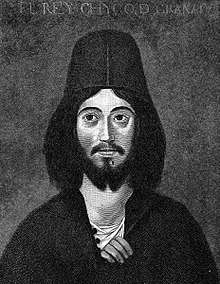 A painting of Muhammad XII of Granada, last Muslim sultan in Spain. Date of this painting and its current location are unknown. | |||||
| Sultan of Granada | |||||
| Sultan of Granada (1st reign) | |||||
| Reign | 1482–1483 | ||||
| Predecessor | Abu l-Hasan Ali | ||||
| Successor | Abu l-Hasan Ali | ||||
| Sultan of Granada (2nd reign) | |||||
| Reign | 1487 – 2 January 1492 | ||||
| Predecessor | Muhammad XIII | ||||
| Successor | none | ||||
| Born | c. 1460 Alhambra, Granada | ||||
| Died | 1533[1] Fes, Morocco[1] | ||||
| Consort | Morayma | ||||
| Issue | Ahmed Aixa (Sor Isabel de Granada) Yusef | ||||
| |||||
| House | Nasrid dynasty | ||||
| Father | Abu l-Hasan Ali, Sultan of Granada | ||||
| Mother | Aixa | ||||
| Religion | Islam | ||||
Sultan
Muhammad XII was the son of Abu l-Hasan Ali, Sultan of the Emirate of Granada whom he succeeded in 1482,[2] as a result of both court intrigue and unrest amongst the population at large.[3]
Muhammad XII soon sought to gain prestige by invading Castile, but was taken prisoner at Lucena in 1483.[2] Muhammad's father was then restored as ruler of Granada, to be replaced in 1485 by his uncle Muhammad XIII, also known as Abdullah ez Zagal.
Muhammad obtained his freedom and Christian support to recover his throne in 1487, by consenting to hold Granada as a tributary kingdom under the Catholic monarchs.[2] He further undertook not to intervene in the Siege of Málaga, in which Málaga was taken by the Christians.
Following the fall of Málaga and Baza in 1487, Almuñécar, Salobreña and Almería were taken by the Christians the following year. By the beginning of 1491, Granada was the only Muslim-governed city in Iberia.
Surrender of Granada
In 1491, Muhammad XII was summoned by Isabella I of Castile and Ferdinand II of Aragon to surrender the city of Granada, which was besieged by the Castilians. Eventually, on 2 January 1492, Granada was surrendered.[2] The royal procession moved from Santa Fe to a place a little more than a mile from Granada, where Ferdinand took up his position by the banks of the Genil. A private letter written by an eyewitness to the Bishop of León only six days after the event recorded the scene:
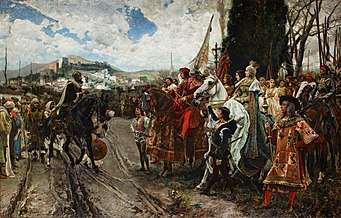
The Moorish sultan, with about eighty or a hundred on horseback and very well dressed, went forth to kiss the hand of their Highnesses. According to the final capitulation the key to Granada will pass into Spanish hands without Muhammad XII having to kiss the hands of Los Reyes, as the Spanish royal couple Isabella and Fernando became known. The indomitable mother of Muhammad XII insisted on sparing her son this final humiliation of kissing the hand of Isabella.
Christopher Columbus seems to have been present; he refers to the surrender:
After your Highnesses ended the war of the Moors who reigned in Europe, and finished the war of the great city of Granada, where this present year 1492 on the 2nd January I saw the royal banners of Your Highnesses planted by force of arms on the towers of the Alhambra.
Exile
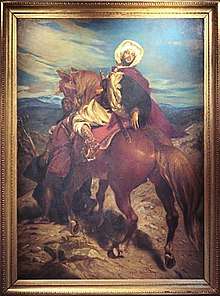
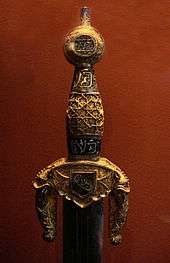
Legend has it that as Muhammad XII went into exile, he reached a rocky prominence which gave a last view of the city. Here he reined in his horse and viewed for the last time the Alhambra and the green valley that spread below. The place where this allegedly took place is today known as the Suspiro del Moro, "the Moor's sigh". Muhammad mourned his loss, and continued his journey to exile accompanied by his mother.
Muhammad XII was given an estate in Laujar de Andarax, Las Alpujarras, a mountainous area between the Sierra Nevada and the Mediterranean Sea, but in October 1493 he crossed the Mediterranean to Fes, Morocco, accompanied by an entourage of 1,130 courtiers and servants. Large numbers of the Muslim population of Granada had already fled to North Africa, taking advantage of a clause in the articles of surrender that permitted free passage.[3]
Letter to the Marinid Sultan of Morocco
Shortly after his surrender, Muhammad Boabdil sent a long letter to the Marinid rulers of Morocco asking for refuge. The letter begins with a long poem praising the Marinids, followed by a prose passage where he laments his defeat and asks forgiveness for past wrongdoings of his forefathers against the Marinids. The entire text was reported by al-Maqqari:[4]
...The lord of Castile has proposed for us a respectable residence and has given us assurances of safety to which he pledged by his own handwriting, enough to convince the souls. But we, as descendants of Banu al-Ahmar, didn't settle for this and our faith in God does not permit us to reside under the protection of disbelief. We also received from the east many letters full of goodwill, inviting us to come to their lands and offering the best of advantages. But we cannot choose other than our home and the home of our forefathers, we can only accept the protection of our relatives, not because of opportunism but to confirm the brotherhood relationship between us and to fulfill the testament of our forefathers, that tells us not to seek any help other than that of the Marinids and not to let anything obstruct us from going to you. So we traversed the vast lands and sailed the tumultuous sea and we hope that we would not be returned and that our eyes will be satisfied and our hurt and grievous souls will be healed from this great pain... – Muhamad Abu Abdallah[4]
North African exile and death
The 17th-century historian Al-Maqqari wrote that Muhammad XII crossed the Mediterranean to Melilla then went to Fes where he built a palace. He stayed there until his death in 1533/1534 (in 940 A.H.).[1][5] He was buried near the Musala (place of the special prayer during the Islamic festivals) located outside of "Bab Sheria" in Fes.[1] Muhammad XII was survived by two sons; Yusef and Ahmed.[1] Al-Maqqari met with his descendants in 1618 in Fes; they lived in a state of poverty and relied on the Zakat.[1]
An alternative final resting place for Muhammad XII is suggested by the late nineteenth century Arabist M.C. Brosselard, who translated a lengthy prescription in Andalusian script on a three-foot long onyx slab held in the town museum of Tlemcen. This epitaph marked the tomb of the exiled king our lord Abu-Abdullah who died in Tlemcen in May 1494, aged thirty-four. The conflict between places and dates of death may arise from confusion between Muhammad XII and his uncle El Zagal, who also died in North African exile.[6]
Spanish chronicler Luis del Mármol Carvajal[7] wrote "Muhammad XII died near the Oued el Assouad (Black River) at ford told Waqûba during the war between the Marinids and the Saadians." This source is also taken by Louis de Chénier, a diplomat of King Louis XVI of France, in his Historical research on the Moors and History of the Empire of Morocco published in Paris in 1787.[8]
Muhammad XII in popular culture
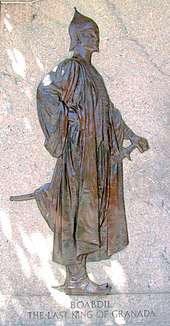
- He is a main character in John Dryden's The Conquest of Granada, a heroic drama in two parts, 1672.
- He is mentioned often by Washington Irving in Tales of the Alhambra (1832), particularly in the chapter "Mementos of Boabdil."
- He was the subject of the three-act opera "Boabdil, der letzte Maurenkönig", Op. 49, written in 1892 by the Jewish-German-Polish composer Moritz Moszkowski.
- Spanish composer Gaspar Cassadó wrote the Lamento de Boabdil for cello and piano, in memory of the king.
- Spanish composer Antón García Abril wrote the 'Elegía a la pérdida de la Alhambra' from his song cycle Canciones del Jardin Secreto for voice and piano; it is set to text (in Andalusian Arabic) that is attributed to Boabdil, in which he laments the loss of the Alhambra.
- Abu Abdallah appears as the main character in "De Ongelukkige" published in 1915 by Dutch author Louis Couperus. This novel covers the last decade of Abu Abdallah's reign as ruler of the Emirate of Granada.
- He figures in the video game Assassin's Creed II: Discovery for the iOS and Nintendo DS, as an ally of the Assassins.
- He is portrayed by Khalid Abdalla in the film Assassin's Creed (2016).
- Andalusian singer-songwriter and poet Carlos Cano dedicated a song to Muhammad XII in his album Crónicas Granadinas, entitled Caída del Rey Chico.
- Salman Rushdie's book, The Moor's Last Sigh, also features consistent references to Muhammad XII.
- He appears as a character in Leo Africanus by Amin Maalouf.
- Louis Aragon's book Le Fou d'Elsa renders a dramatized and poetic version of the story of Granada's capture, which includes Muhammad XII as one of the two main characters present in the novel, (Majnun being the other. Elsa, whom it could be argued is the second major character, is absent from the book.).
- Pakistan Television Corporation (PTV) produced a drama in 1980, based on the novel "Shaheen" by Nasim Hijazi. In this drama Abu Abdullah Mohammad was played by Shakeel Ahmed.
- Also in 1980 (22 November until 7 February 1981), appeared in the comics supplement to the Portuguese newspaper A Capital a 12-page comics story on the conquest of Granada with Boabdil as the main character, Luz do Oriente ("Light of the Orient"). The script was by popular literature writer and bookman Jorge Magalhães and the drawing was by Portuguese-Guinean sculptor, painter and comic book artist Augusto Trigo.[9]
- Boabdil appeared as main character in Spanish eight-episode serial Requiem por Granada (1991). In this serial, he was played by Manuel Bandera. Young Boabdil was played by Lucas Martín.
- Boabdil appeared as main character in the season two of the Spanish TV Series Isabel (2013). In this show, he was played by Álex Martínez.
- He appeared as a main character in the novel Court of Lions (2017) by Jane Johnson.
- He appears as a character in G. Willow Wilson’s novel, The Bird King (2019), which is set during 1491 and the arrival of the Spanish Inquisition. The protagonist Fatima is his concubine.
- Nathaniel Mackey’s poem “Sigh of the Moor” in Splay Anthem is built around the motif of “Boabdil’s / abdicated kingdom.”
See also
- Al Andalus
- Alhambra Decree
- Reconquista
- Treaty of Granada
Further reading
- Lytton, Edward Bulwer Lytton (1838). Leila; or, The Siege of Granada. London. Retrieved 31 January 2018.
This is a historical novel from 1838, and should not be used as a historical source.
References
- "نفح الطيب من غصن الاندلس الرطيب" p. 1317. احمد المقري المغربي المالكي الاشعري
- Chisholm, Hugh, ed. (1911). . Encyclopædia Britannica. 4 (11th ed.). Cambridge University Press. p. 94.
- Drayson, Elizabeth. The Moor's Last Stand How Seven Centuries of Muslim Rule in Spain Came to an End (First ed.). Northampton, MA. p. 11. ISBN 978-1-56656-004-7. OCLC 969827670.
- "نفح الطيب من غصن الاندلس الرطيب" p. 1325. احمد المقري المغربي المالكي الاشعري
- Harvey, Leonard Patrick (1992). Islamic Spain, 1250 to 1500. Chicago: University of Chicago Press. p. 327. ISBN 0-226-31962-8.
- Drayson, Elizabeth. "7". The Moor's Last Stand: How Seven Centuries of Muslim Rule in Spain Came to an End (First ed.). Northampton, MA. ISBN 978-1-56656-004-7. OCLC 969827670.
- Shillington, Kevin (2005). Encyclopedia of African history. 1. CRC Press. p. 220. ISBN 1-57958-245-1.
- Recherches historiques sur les Maures, et histoire de l'empire de Maroc, Volume 2, p. 341, at Google Books and Volume 3, p. 303, at Google Books (in French)
- Quadradinhos, II series, number 26 (22 November 1980) to 37 (7 February 1981), newspaper A Capital. Published in book-form as Luz do Oriente, Editorial Futura, Lisbon, 1986
Muhammad XII of Granada Cadet branch of the Banu Khazraj Born: 1460? Died: 1533? | ||
| Regnal titles | ||
|---|---|---|
| Preceded by Abu l-Hasan Ali |
Sultan of Granada 1482–1483 |
Succeeded by Abu l-Hasan Ali |
| Preceded by Muhammed XIII |
Sultan of Granada 1487–1492 |
Granada captured by Castile |
.svg.png)